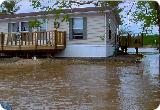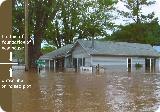Innovative Flooding Idea:
Elevating the Land Rather Than the Structure
Gays Mills, WI —In June 2008, when the Kickapoo River in Wisconsin overflowed after a deluge, homes around town were submerged in six feet or more of brownish water. But not Mason Evans’ and his wife’s, Diane, home. Learning from the floods of 1978 and 2007, the Evans’ home was high and dry, because of their choice to elevate the land and prevent history from repeating itself.
During the flood of 1978, the Evans’ former home was under two feet of water. The mold infestation rendered it unsafe for habitation, and subsequently, they demolished the flood-damaged structure. The total losses for that flood came to about $50,000, approximately what the property was worth in terms of his initial investment and property values at the time. After the flood of 1978, Evans purchased flood insurance, in order to protect his investment against the next flood.
When another flood in August 2007 inundated the Evans’ home again, the damage was far worse than the 1978 flood. Four days of rain pushed the Kickapoo River over its banks, engulfing the entire town of Gays Mills with more than six feet of water. Like everyone else in town, the Evans grabbed everything of value they could think of and left their home for higher ground.
A week later, when the water level went down, Evans re-entered his house along with 36 friends to start the cleanup phase. After they disposed of every square yard of ruined carpeting, gutted the water-soaked drywall and insulation, and threw out all of the ruined furniture and cabinetry, the house was just a reeking, waterlogged shell. Total losses this time came to $150,000.
His combined losses from the 1978 and 2007 flood came to well over $200,000. In addition to his flood insurance payment, which covered a portion of his losses, he also received a Federal Emergency Management Agency (FEMA) grant for roughly $28,000. Evans remarked that it wasn’t more than a week later that a check came through the mail. “It was surprising how quickly FEMA reacted,” said Evans, “I called in and registered, then inspectors came out and looked over the damage that same week.”
Evans then made a proactive decision and decided he was not going to be a flood victim again.
He remembered specialists from FEMA’s Mitigation Directorate talking about structural elevation. Although it was too late for his waterlogged house, he owned another piece of land where he could rebuild. Evans decided that rather than elevating the structure, which is the usual method, he would elevate this large piece of land to three feet above the Base Flood Elevation (BFE). The BFE is the minimum standard that many communities use to regulate floodplain development under the National Flood Insurance Program (NFIP). It is assumed that there is a 1-percent chance per year that floodwaters could reach the BFE. In his case, raising the level of his house plot to above the minimum BFE would reduce his chances of floodwaters reaching his new home.
Crawford County,
Wisconsin



Quick Facts
Year:
2007
Sector:
Private
Cost:
$54,000.00 (Actual)
Primary Activity/Project:
Elevation, Structural
Primary Funding:
Other FEMA funds/ US Department of Homeland Security

